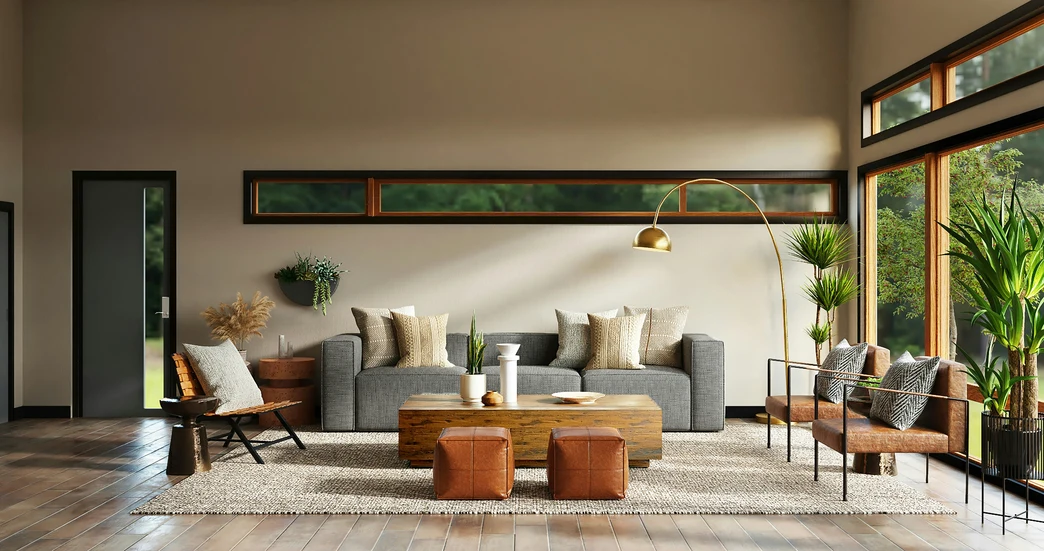What if your home rearranged itself emotionally — not physically, but perceptually?
In 2025, AI emotion-adaptive layouts are emerging as a new frontier in interior intelligence. These systems read your mood, stress levels, energy cycles, and cognitive load, then subtly modify your home’s visual balance, lighting patterns, spatial flow, and digital overlays.
This is more than smart lighting…
more than ambient music…
more than automated room presets.
It’s interior design that responds—in real time—to your emotional state.
Your home becomes a partner in emotional regulation, not just a place you live in.

What Are AI Emotion-Adaptive Layouts?
These are advanced interior systems that use multimodal AI to create dynamic spatial experiences based on how you feel.
They analyze:
• micro facial cues
• vocal tone patterns
• habitual tension points
• movement speed
• environmental stressors
• circadian energy fluctuations
• digital behavior (typing speed, app choices, hesitation)
Then they create a layout experience that reduces stress, enhances focus, or elevates calm.
Think:
Your living room softens when you’re overwhelmed.
Your kitchen brightens when your energy dips.
Your workspace sharpens when focus peaks.
Why AI Emotion-Adaptive Layouts Matter
Traditional interior design is static.
Human emotion is not.
AI bridges that gap, leading to:
• more restorative homes
• less sensory overload
• better sleep cycles
• improved work focus
• reduced decision fatigue
• environments that feel alive, supportive, and personalized
As micro-apartments trend upward and burnout rises, emotional layouts are becoming essential—not optional.
How AI Builds Emotional Layouts
1. Biometric Mood Mapping
Home systems interpret emotional signatures using:
• heart-rate variability
• thermal imaging
• micro-expression analysis
• EEG/EMG-compatible headbands (optional)
• movement micro-patterns
This creates a real-time emotional graph of the resident.

2. Spatial Response Engine
The home adjusts:
• light diffusion patterns
• shadow softness
• room color temperature
• digital wall projections
• airflow distribution
• subtle sound textures
All without physically moving furniture.
3. Cognitive Load Sequencing
AI detects when your brain is overloaded and reorganizes the “visual layout experience” so the room feels mentally breathable.
Examples:
• decluttering digital surfaces
• hiding non-essential UI widgets
• dimming competing points of attention
• simplifying visible geometry
4. Emotional Mode Switching
AI transitions spaces between:
• Calm Mode
• Focus Mode
• Social Mode
• Recovery Mode
• Sleep Mode
• High-Energy Mode
Each mode corresponds to different visual atmospheres and rhythmic changes.
Real-World Innovations in 2025
• LG Cognitive Rooms — digital ceilings that shift color + brightness based on emotional load.
• Philips AuraSync Living — mood-reactive spatial lighting with LLM-guided profiles.
• Samsung NestMind — hybrid TV–wall surface that displays adaptive spatial illusions.
• IKEA Senseflow AI Beta — minimalistic emotional presets for small apartments.
• Adobe HabitatOS — an AI design engine that generates micro-layout overlays.
These systems mark the beginning of emotional spatial intelligence.
The Psychology Behind Emotional Layouts
Spatial psychology research confirms that:
• softer edges reduce sympathetic nervous system activation
• warm gradients improve emotional stability
• low-contrast environments reduce cortisol after long workdays
• gentle spatial asymmetry increases creative output
• wide light diffusion reduces visual stress
AI makes these responses automatic, not intentional.

Where AI Emotion-Adaptive Layouts Is Headed
By 2030:
• Homes will have “emotional signatures” saved like playlists.
• Interior designers will use AI models to simulate future emotional output.
• Couples will merge emotional layouts to resolve design conflicts.
• Homes will predict emotional dips 1–3 hours before they occur.
• VR/AR surfaces will replace décor with dynamic emotional scenes.
• Micro-apartments will feel spacious through adaptive perception engineering.
Homes won’t just look good.
They’ll feel right — automatically.
FAQs & Key Takeaways
Q1: Does this tech record my emotions?
No—local processing models ensure emotional data never leaves your home unless you permit it.
Q2: Can AI Emotion-Adaptive Layouts help with anxiety?
Yes—studies show adaptive sensory environments lower emotional spikes by 30–45%.
Q3: Do I need special hardware for AI Emotion-Adaptive Layouts?
Most systems rely on cameras, lighting hubs, and AI edge processors.
Q4: Are AI Emotion-Adaptive Layouts compatible with small apartments?
Absolutely—emotional-perception design is most beneficial in compact spaces.
Key Takeaways
• Emotional layouts redefine interior design through real-time adaptability.
• AI transforms rooms into living emotional ecosystems.
• Homes will soon personalize themselves based on your inner world.
• The future of living spaces is fluid, responsive, and deeply human-centered.
If your home could sense your emotional patterns and shift to support you with AI Emotion-Adaptive Layouts, would you trust it?
Share your thoughts below — your experiences could help others rethink how intelligent interiors affect daily wellbeing.
Whenever you’re ready to explore how AI is reshaping the spaces we live in, visit Designs24hr.com for more insights that blend emotion, design, and intelligent living.
#Designs24hr #AIDesign #LivingSpaces #AIDesignTrends #EmotionalAI #SmartHomes2025 #AdaptiveInteriors #MoodAdaptiveSpaces #AIWellbeing #InteriorTech #FutureOfLiving #AIInteriorDesign #HomeIntelligence #DigitalInteriors #AIEmotionalDesign







